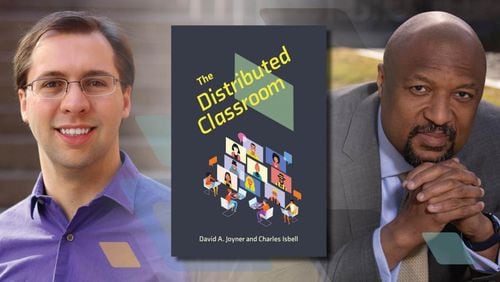Two prominent Georgia Tech computer scientists maintain online classes can be as effective as face-to-face instruction and urge expansion of opportunities that liberate students from the confines of a classroom and an 8 a.m. to 3 p.m. daily schedule.
The ambitious vision of online education in the new book “The Distributed Classroom” by David A. Joyner and Charles Isbell could be a tough sell. Along with hearing from lots of K-12 parents this year about their children’s disappointing virtual experiences during the COVID-19 pandemic, many parents in Georgia Tech forums bemoaned the migration to remote learning and contended their college kids were essentially teaching themselves.
No matter the age of their children, most parents favor a return to “normal school,” which they define as how they learned — a teacher in front of a room and students in desks. Can they warm to Isbell’s and Joyner’s call for classes that are not restricted in time or space but distributed across multiple locations and times, breaking with the belief that students and teachers must meet together in a room at fixed times?
“My suspicion is that the negative experiences of the past several months may have damaged the reputation of online education itself, but that many of the features and programs we’ve developed due to this emergency transition are going to have a positive impact going forward,” said Joyner, executive director of online education and the popular OMSCS program, online master of science in computer science, in Tech’s College of Computing. “There were lots of things that didn’t go well, and it’s definitely turned many people off to the idea of online education.”
However, Joyner added, “We saw during the pandemic that college professors’ opinion of online learning improved, and there are several features we developed over the past year that students want to continue, such as recorded classes. Going forward, I think we have to disentangle several developments that went together during COVID-19, but don’t have to go together going forward.”
In an interview, Isbell and Joyner agreed that online education doesn’t mean a child at the kitchen table staring at a screen all day. They said students can take online classes while still going to school each day. And online learners can form bonds, as do the grad students in Tech’s OMSCS program, which utilizes a fleet of teaching assistants to lead review sessions, answer questions and evaluate student work. The grad students, who often live in major cities that are tech hubs, organize their own social meetups.
The experiences of students in Tech’s groundbreaking master’s program undergird “The Distributed Classroom.” Begun in 2014, the OMSCS program had 11,000 active students as of this spring, along with 3,500 alums whose graduate degrees cost them between $6,900 and $8,400, far lower than traditional programs. It has inspired online Tech master’s programs in analytics and cybersecurity. In the spring, the three programs comprised 16,594 students, representing 42% of Tech’s total enrollment for the term.
As an example of how the online model could improve K-12, the authors posit an algebra class where some students will require extra time while others are ready to advance. In a traditional class, the teacher instructs all those students at once, ensuring either some will be left behind or some will be held back. Online learning can fill in by allowing the experience to be tailored so those students who need more time and practice can receive it, while those ready to move ahead can do so.
“It’s not that there is a type of student for whom online works better; it is that different learners require different supports to be successful. Online learning grants more flexibility to give individual learners the support they need — but only if we take advantage of that flexibility. Too often, however, online learning experiences are designed to directly mimic the in-person experience, which both loses some of the advantages of the in-person experience and fails to capitalize on the potential of the online experience,” said Joyner.
“My son in seventh grade thrived in this online environment last year,” said Isbell, who is dean of the College of Computing and the John P. Imlay Jr. chair. “He could do things on his own schedule. He worked with other students taking some of the same classes. It gave him quite a bit of control.”
Isbell said there will be a learning curve to developing effective online classes, especially in K-12. Citing the evolution of stage plays to film, Isbell said, “We are at the point in online education where we are recording people doing plays on stage.”
So how can parents be won over? The authors cited Tech’s own experience developing an online version of Introduction to Computing. To expand access to computing education, Tech had to accommodate more students as every student is now required to take a CS1 course.
Tech emphasized that it was seeking a positive student experience, and was “not simply throwing an unprepared faculty member into a new environment. We selected an instructor who specialized in online instruction; we selected a platform that we felt offered significant advantages to the student experience and we surrounded that instructor with resources to develop something promising,” said Joyner.
Over the first few semesters, Tech gave assessments and surveys across the new online class and the traditional class to make sure students were achieving the same outcomes. Tech found students in the online section learned just as much or more in fewer hours per week and experienced less stress.
Georgia Tech had the luxury of time and expertise to develop its online courses, drawing on its own computer scientists to both design and teach classes. There is not yet that expertise in many local school districts.
“The people teaching the next round of teachers need to take ownership on how best to train them to take advantage of these new tools and needs of their students,” said Isbell. “They are going to have to see this as part of the mission.”
About the Author







